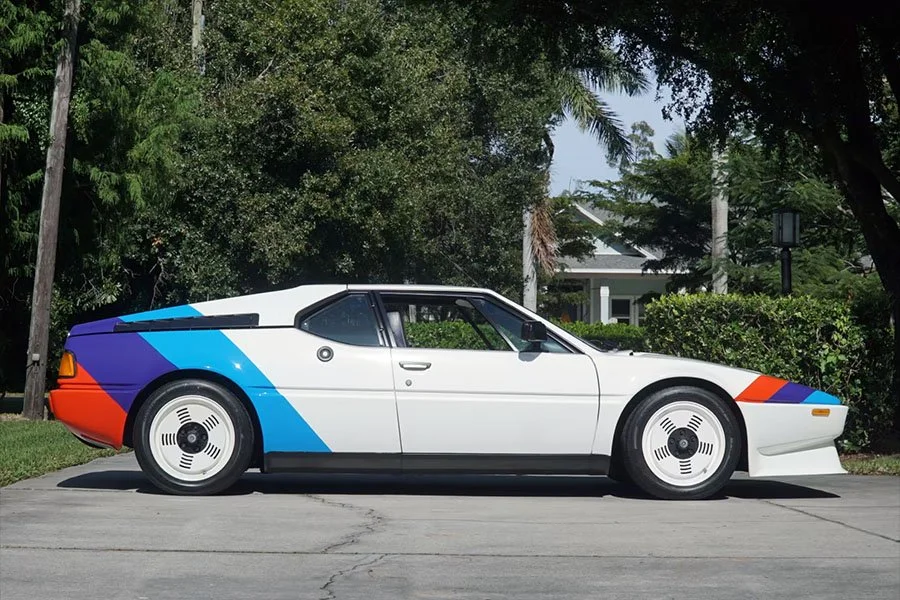Guide: BMW Art Car #3 - BMW E21 320i Gr.5 Turbo 'Roy Lichtenstein'
/BACKGROUND
Having commissioned the first two instalments of its burgeoning Art Car theme in time for the 1975 and ‘76 Le Mans 24 Hour races, BMW went on to order a third machine that would appear at the French all day and night classic of 1977.
Like cars one and two, an American artist was brought on board for this latest creation. Having selected an example of the firm’s E21 3-series based 320i Group 5 racing car as the basis, BMW turned to Roy Lichtenstein, the man commonly regarded as the father of American pop art and who went on to produce arguably the most highly regarded piece of work in the entire Art Car series
BMW E21 320I GROUP 5
Although in 3.5-litre Group 5 trim the E9-based CSL had still been winning races at World Championship level for BMW Motorsport right up until the end of the 1976 season, the Munich firm elected to switch focus to the under two-litre category for 1977.
That season, the BMW Junior Team would attack domestic series like the Deutsche Rennsport Meisterschaft (DRM) while McLaren North America would manage an official IMSA campaign. Additional cars would also be supplied to factory supported outfits like Alpina, GS Tuning and Eggenberger Motorsport.
Powered by a two-litre turbocharged inline four cylinder DOHC 16 valve engine that developed upwards of 300bhp, the 320i instantly established itself as the premier Division 2 class contender in Group 5 despite having gone from drawing board to race track in less than three months.
ROY LICHTENSTEIN
Born in New York in 1923, Roy Lichtenstein developed an interest in art during his time at school when, as an avid jazz fan, he would paint portraits of musicians playing their instruments.
During 1939, Lichtenstein enrolled in summer classes at the Art Students League of New York where he worked under the tutelage of renowned painter, Reginald Marsh.
Following graduation from high school in 1940, Lichtenstein went on to take a fine art degree at Ohio State University which was interrupted by a three-year stint in the US Army between 1943 and 1946 where he served as an orderly, draftsman and artist. On his return to Ohio State, Lichtenstein became greatly influenced by another of his professors, the artist Hoyt L. Sherman.
Lichtenstein’s work evolved to straddle cubism and abstract expressionism; he had his first solo exhibition at the Carlebach Gallery in New York during 1951, but continued to work mostly as an art teacher until 1964.
In 1960, Lichtenstein began to teach at Rutgers University in New Jersey alongside installation artist and painter, Allan Kaprow. Lichtenstein’s rise to prominence followed soon after with his ‘industrial’ work that explored the relationship between art, advertising and consumerism in popular culture such as comic books and advertisements.
Lichtenstein’s first pop art work appeared in 1961 and heralded a completely new style of painting that used cartoon images and techniques derived from the appearance of commercial printing. This phase would continue until 1965 caricatured as the ‘American Way of Life’.
Worldwide fame followed with Lichtenstein’s best-known works having been inspired by comic book panels, a subject he continued to incorporate into his work during later decades.
Having purchased a former carriage house in Long Island during 1970, Lichtenstein built a studio on the property and spent the rest of the decade in relative seclusion.
LICHTENSTEIN’S 320I GROUP 5
With its litany of Benday Dots and Speedlines reminiscent of Lichtenstein’s famous comic strip-style, the American painter’s commission from BMW was a pop art masterpiece that harmoniously combined the aerodynamics of the E21’s bodywork with the aesthetics of his art.
It was also an expression of Lichtenstein’s artistic philosophy that art must be an element of everyday life; the sunrise and sunset motifs on the doors depicted the landscape viewed by drivers racing at the Le Mans 24 Hours.
Lichtenstein said of his creation:
"I pondered on it for a long time and put as much into it as I possibly could. The painted lines symbolize the road the car has to follow and the artwork also portrays the surroundings through which the car is being driven. Even the sky and sunlight are to be seen… you could list all the things a car experiences – the only difference is that this car mirrors all these things even before it takes to the road.”
1977 LE MANS 24 HOURS
Following a presentation at at the Georges Pompidou Centre of Art & Culture in Paris, Roy Lichtenstain’s BMW headed to the 1977 Le Mans 24 Hours which took place over the weekend of June 11th and 12th.
Driving duties were allocated to father of the BMW Art Car programme, Herve Poulain, who was joined in the works-tended car by fellow Frenchman, Marcel Mignot.
Running in the IMSA GT class, Poulain and Mignot qualified 49th of the 55 starters.
The race started in cool, blustery conditions and the top order was decimated by a series of early retirements. Overnight, heavy rain swept in which lasted until just after dawn. By the afternoon, the circuit was basking in blazing heat and, after a trouble-free run, Poulain and Mignot broke into top ten during the 22nd hour.
Of the 55 starters, only 21 were still running at the end. The Art Car ultimately came home ninth overall and second in IMSA GT, four laps behind the class-winning Luigi Racing BMW E9 CSL of Pierre Dieudonne, Jean Xhenceval and Spartaco Dini.
Text copyright: Supercar Nostalgia
Photo copyright: BMW - https://www.bmw.com


































